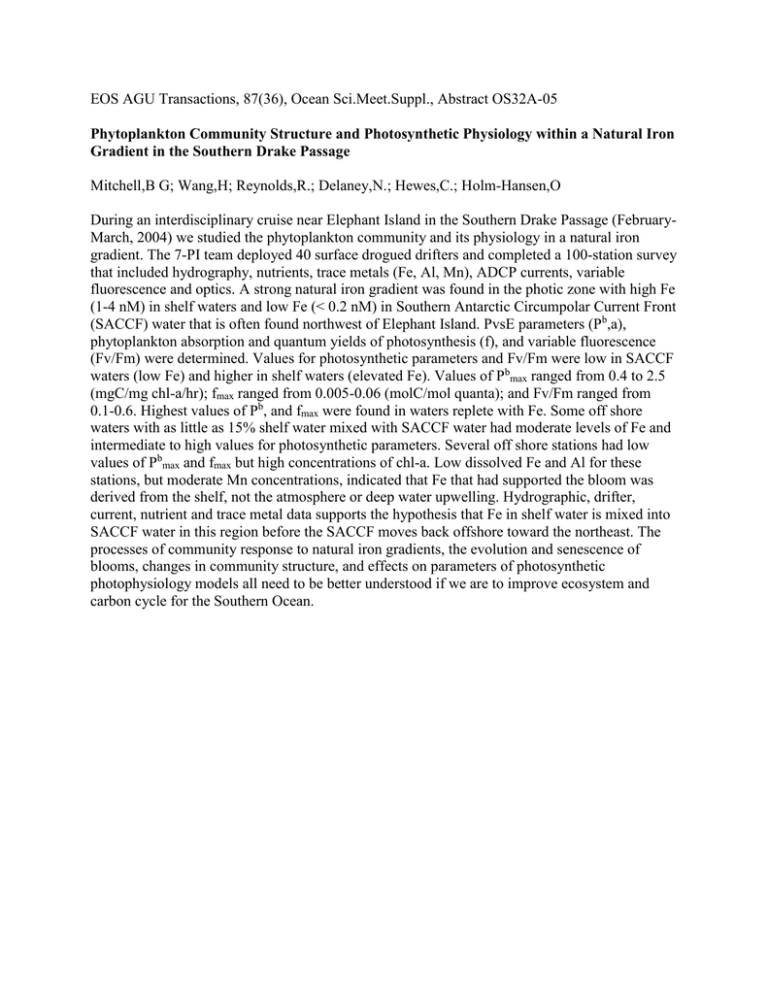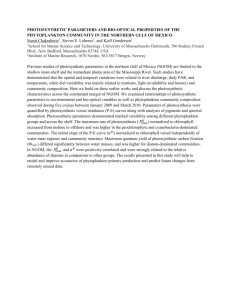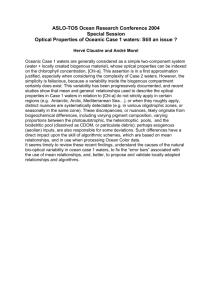EOS AGU Transactions, 87(36), Ocean Sci.Meet.Suppl., Abstract OS32A-05
advertisement

EOS AGU Transactions, 87(36), Ocean Sci.Meet.Suppl., Abstract OS32A-05 Phytoplankton Community Structure and Photosynthetic Physiology within a Natural Iron Gradient in the Southern Drake Passage Mitchell,B G; Wang,H; Reynolds,R.; Delaney,N.; Hewes,C.; Holm-Hansen,O During an interdisciplinary cruise near Elephant Island in the Southern Drake Passage (FebruaryMarch, 2004) we studied the phytoplankton community and its physiology in a natural iron gradient. The 7-PI team deployed 40 surface drogued drifters and completed a 100-station survey that included hydrography, nutrients, trace metals (Fe, Al, Mn), ADCP currents, variable fluorescence and optics. A strong natural iron gradient was found in the photic zone with high Fe (1-4 nM) in shelf waters and low Fe (< 0.2 nM) in Southern Antarctic Circumpolar Current Front (SACCF) water that is often found northwest of Elephant Island. PvsE parameters (Pb,a), phytoplankton absorption and quantum yields of photosynthesis (f), and variable fluorescence (Fv/Fm) were determined. Values for photosynthetic parameters and Fv/Fm were low in SACCF waters (low Fe) and higher in shelf waters (elevated Fe). Values of Pbmax ranged from 0.4 to 2.5 (mgC/mg chl-a/hr); fmax ranged from 0.005-0.06 (molC/mol quanta); and Fv/Fm ranged from 0.1-0.6. Highest values of Pb, and fmax were found in waters replete with Fe. Some off shore waters with as little as 15% shelf water mixed with SACCF water had moderate levels of Fe and intermediate to high values for photosynthetic parameters. Several off shore stations had low values of Pbmax and fmax but high concentrations of chl-a. Low dissolved Fe and Al for these stations, but moderate Mn concentrations, indicated that Fe that had supported the bloom was derived from the shelf, not the atmosphere or deep water upwelling. Hydrographic, drifter, current, nutrient and trace metal data supports the hypothesis that Fe in shelf water is mixed into SACCF water in this region before the SACCF moves back offshore toward the northeast. The processes of community response to natural iron gradients, the evolution and senescence of blooms, changes in community structure, and effects on parameters of photosynthetic photophysiology models all need to be better understood if we are to improve ecosystem and carbon cycle for the Southern Ocean.


